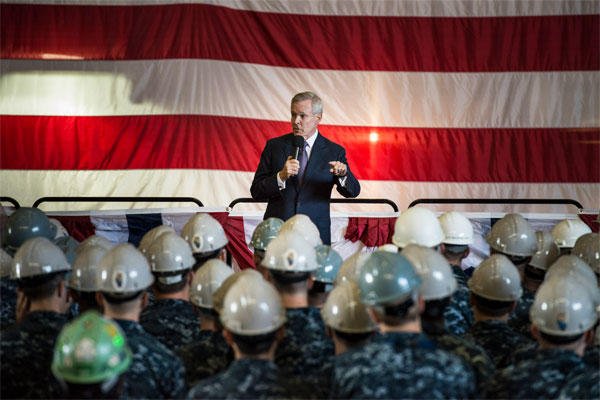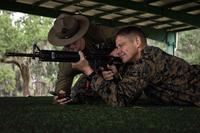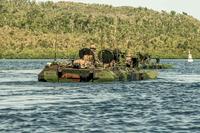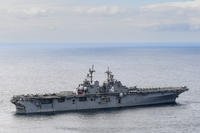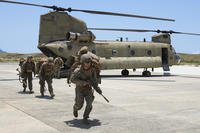WASHINGTON – Navy Secretary Ray Mabus has flown more than 900,000 miles and spoken with thousands of sailors and Marines since taking office more than five years ago.
The morale of the force is high, he told the Defense Writers’ Group today. And sailors, Marines and their families all tell him, he said, that they want more predictability in deployments and from Congress.
More predictability in deployments
The length of deployments in the Navy has gone up, Mabus said, but, he added, “One of the things that I get from sailors is it is not so much the length of the deployments. It’s the need for certainty.”
Sailors and Marines understand that it is tough to predict events in an uncertain world, the secretary said. Events have a vote of their own, he added, and sometimes deployments have to be extended.
“For the Bataan [Amphibious Ready Group] this is the second consecutive cruise they have been extended [on],” he said. “It’s one of the reasons we now have a special pay for those extended.”
That means if sailors are at sea for more than 220 days in a row, they receive extra pay.
“They are concerned about predictability. How long will they be out? How will their families know?” Mabus said. “Two years ago, we stopped a carrier two days before it was supposed to be going. Some people had rented [out] their apartments.”
Concerns about sequestration
When the secretary is on the road meeting sailors and Marines he said he receives a lot of sophisticated questions about sequestration. “They are worried about the effect it will have on them and on the Navy,” he said. “I try to tell them where we are: ‘I think sequester is dumb, most people think it’s dumb.’”
He tells them that Congress has partially fixed it for 2015 and 2016, but “it’s still the law and it will kick back in on January 2016 unless something happens.”
Navy at right size
Sailors also ask about the size of the force and what the outlook is five years from now. “We are growing the fleet,” Mabus said. The service dropped dramatically in size between 2001 and 2008, when it went from 316 ships to 278. On the manpower side, the Navy lost 90,000 sailors over that time.
“Our plans are that we are at 324,000 sailors on active duty and that’s the number we need and expect to keep over the next five years,” he said.
Getting there has been tough. The service implemented enlisted retention boards and the perform-to-serve program, “which was as unpopular as anything I have seen, and rightfully so, but we had certain ratings that were over-manned and others under-manned and we had to balance the force out,” he said.
“That’s over. That’s done with,” Mabus said. “We’ve got people where we need them now. We may have to do ones and twos here and there but nothing like in the past.”
Military retirement
Even from first-termers, Mabus gets questions about military retirement and he tells them that whatever happens, anyone in the service will retire using the system in place when they entered the military.
And he is blunt in talking about reducing the rate of increase of pay and benefits. “I tell them straight up that we are going to have to slow the growth,” he said. “Either they are going to get less training or they will have fewer weapons and platforms. Their quality of work is going to go down … if we don’t slow the rate of increase.”
OK to wear ship’s ball cap
Then, there are other issues and concerns important to service members. While speaking with sailors Mabus started getting questions about why sailors couldn’t wear their ball caps with their ship’s name on them ashore. The Navy secretary didn’t know why and neither did Chief of Naval Operations Adm. Jonathan W. Greenert.
“We sent out a two-sentence order saying it’s all right to wear your ball caps,” Mabus said. “I get thanked for that every place I go. It’s a big thing for unit morale and people just appreciated it.”
Overall, the service has the best force it’s ever had, Mabus said. “They are willing to do anything,” he said. “You give these young men and women an order and they will meet it. They would like certainty, but they are rightfully proud -- both Navy and Marines -- about what they do.”
In many parts of the world, these sailors and Marines will be the only Americans many foreigners will ever meet. “They know they represent the United States around the world to a lot of different people,” the Navy secretary said.
